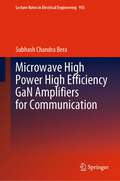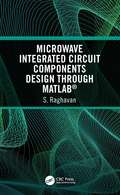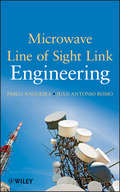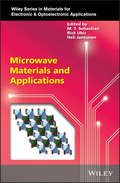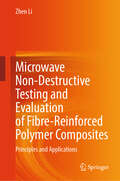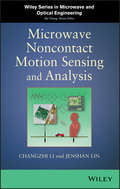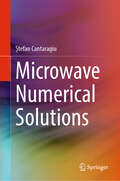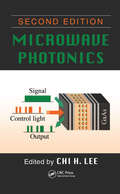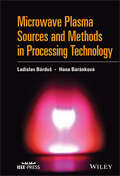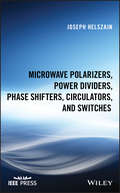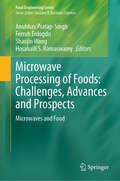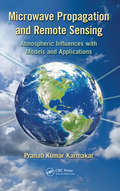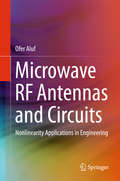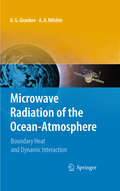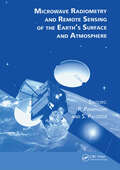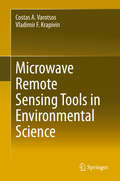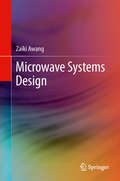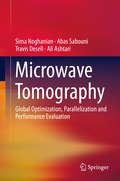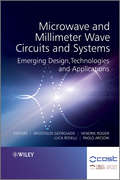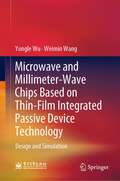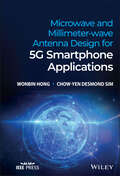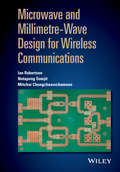- Table View
- List View
Microwave High Power High Efficiency GaN Amplifiers for Communication (Lecture Notes in Electrical Engineering #955)
by Subhash Chandra BeraThe textbook discusses design and analysis of microwave high power and high efficiency amplifiers for communications, appropriate for undergraduate, post-graduate students, practical circuit designers and researchers in the field of electronics and communication engineering. This book covers basics of III-V group semiconductor materials and GaAs and GaN based High Electron Mobility Transistors (HEMTs) most suitable for microwave and mm wave power amplifiers required for present wireless communication systems and upcoming 4G and 5G mobile base stations. The book describes design and analysis of classical class of amplifier operations such as Class-A, B, AB, C and F. The coverage extends to advanced classes of amplifier operation such as extended continuous Class-B/Class-J, and extended continuous Class-F operations for broadband, high power and high efficiency performance. Analytical expressions are derived for circuit elements and performance parameters for clear understanding and required for practical design of power amplifiers. Each topic is supplemented with suitable schematic diagrams, analytical expressions and plotted results for clear understanding.
Microwave Integrated Circuit Components Design through MATLAB®
by S RaghavanMICROWAVE INTEGRATED CIRCUIT COMPONENTS DESIGN THROUGH MATLAB® This book teaches the student community microwave integrated circuit component design through MATLAB®, helping the reader to become conversant in using codes and, thereafter, commercial software for verification purposes only. Microwave circuit theory and its comparisons, transmission line networks, S-parameters, ABCD parameters, basic design parameters of planar transmission lines (striplines, microstrips, slot lines, coplanar waveguides, finlines), filter theory, Smith chart, inverted Smith chart, stability circles, noise figure circles and microwave components, are thoroughly explained in the book. The chapters are planned in such a way that readers get a thorough understanding to ensure expertise in design. Aimed at senior undergraduates, graduates and researchers in electrical engineering, electromagnetics, microwave circuit design and communications engineering, this book: • Explains basic tools for design and analysis of microwave circuits such as the Smith chart and network parameters • Gives the advantage of realizing the output without wiring the circuit by simulating through MATLAB code • Compares distributed theory with network theory • Includes microwave components, filters and amplifiers S. Raghavan was a Senior Professor (HAG) in the Department of Electronics and Communication Engineering, National Institute of Technology (NIT), Trichy, India and has 39 years of teaching and research experience at the Institute. His interests include: microwave integrated circuits, RF MEMS, Bio MEMS, metamaterial, frequency selective surfaces (FSS), substrate integrated waveguides (SIW), biomedical engineering and microwave engineering. He has established state-of-the-art MICs and microwave research laboratories at NIT, Trichy with funding from the Indian government. He is a Fellow/Senior Member in more than 24 professional societies including: IEEE (MTT, EMBS, APS), IETE, IEI, CSI, TSI, ISSS, ILA and ISOI. He is twice a recipient of the Best Teacher Award, and has received the Life Time Achievement Award, Distinguished Professor of Microwave Integrated Circuit Award and Best Researcher Award.
Microwave Line Of Sight Link Engineering
by Pablo Angueira Juan Antonio RomoA comprehensive guide to the design, implementation, and operation of line of sight microwave link systems The microwave Line of Sight (LOS) transport network of any cellular operator requires at least as much planning effort as the cellular infrastructure itself. The knowledge behind this design has been kept private by most companies and has not been easy to find. Microwave Line of Sight Link Engineering solves this dilemma. It provides the latest revisions to ITU reports and recommendations, which are not only key to successful design but have changed dramatically in recent years. These include the methodologies related to quality criteria, which the authors address and explain in depth. Combining relevant theory with practical recommendations for such critical planning decisions as frequency band selection, radio channel arrangements, site selection, antenna installation, and equipment choice, this one-stop primer: Describes the procedure for designing a frequency plan and a channel arrangement structure according to ITU current standards, illustrated with specific application examples Offers analytical examples that illustrate the specifics of calculations and provide order of magnitude for parameters and design factors Presents case studies that describe real-life projects, putting together the puzzle pieces necessary when facing a real design created from scratch Microwave Line of Sight Link Engineering is an indispensable resource for radio engineers who need to understand international standards associated with LOS microwave links. It is also extremely valuable for students approaching the topic for the first time.
Microwave Materials and Applications
by Heli Jantunen Mailadil T. Sebastian Rick UbicThe recent rapid progress in wireless telecommunication, including the Internet of Things, 5th generation wireless systems, satellite broadcasting, and intelligent transport systems has increased the need for low-loss dielectric materials and modern fabrication techniques. These materials have excellent electrical, dielectric, and thermal properties and have enormous potential, especially in wireless communication, flexible electronics, and printed electronics. Microwave Materials and Applications discusses the methods commonly employed for measuring microwave dielectric properties, the various attempts reported to solve problems of materials chemistry and crystal structure, doping, substitution, and composite formation, highlighting the processing techniques, morphology influences, and applications of microwave materials whilst summarizing many of the recent technical research accomplishments in the area of microwave dielectrics and applications Chapters examine: • Oxide ceramics for dielectric resonators and substrates • HTCC, LTCC and ULTCC tapes for substrates • Polymer ceramic composites for printed circuit boards • Elastomer-ceramic composites for flexible electronics • Dielectric inks • EMI shielding materials • Microwave ferrites A comprehensive Appendix presents the fundamental properties for more than 4000 low-loss dielectric ceramics, their composition, crystal structure, and their microwave dielectric properties. Microwave Materials and Applications presents a comprehensive view of all aspects of microwave materials and applications, making it useful for scientists, industrialists, engineers, and students working on current and emerging applications of wireless communications and consumer electronics.
Microwave Non-Destructive Testing and Evaluation of Fibre-Reinforced Polymer Composites: Principles and Applications
by Zhen LiThis book provides a detailed exploration of microwave testing, a Non-Destructive Testing (NDT) method fully recognized by the American Society for Non-Destructive Testing (ASNT) within the past decade. Designed with a special focus on carbon fibre- and glass fibre-reinforced polymer composites, it addresses the needs of industries where these advanced materials are increasingly used, including aerospace, wind energy, electronics, marine, automotive, construction, sports and piping. For NDT practitioners, understanding this new technique is essential. The book offers an in-depth analysis of the electromagnetic properties of composites. In addition, a thorough discussion of the detection principles, advantages and applications of various methods is presented. The methods are not limited to composites and can be readily adapted to other dielectric materials. This handbook is tailored for engineers and researchers specialising in NDT of composites. It also doubles as a reference for graduate students and senior undergraduates studying microwave engineering or composite materials. Elevate your expertise in microwave testing with this essential guide—crafted for professionals, researchers, and educators driving innovation in advanced non-destructive testing and evaluation.
Microwave Noncontact Motion Sensing and Analysis
by Jenshan Lin Changzhi LiAn authoritative guide to the theory, technologies, and state-of-the-art applications in microwave noncontact sensing and analysisEngineering researchers have recently developed exciting advances in microwave noncontact sensing and analysis, with new applications in fields ranging from medicine to structural engineering, manufacturing to transportation. This book provides an authoritative look at the current state-of-the-art in the field.Drawing upon their years of experience in both cutting-edge research and industry applications, the authors address microwave radar for both noncontact vital sign detection and mechanical movement measurement. They explore key advances in everyday applications of microwave and Doppler radar, especially in the areas of radio frequency technologies, microelectronic fabrication processes, and signal processing hardware and algorithms.Microwave Noncontact Motion Sensing and Analysis:Reviews the theory and technical basics, from electromagnetic propagation to signal processingDiscusses all major types of motion sensing radar, including Doppler, pulse, and FMCWExplores important advances in detection and analysis techniquesUses numerous case studies to illustrate current applications in an array of fieldsProvides integrated coverage of human vital sign detection, through-wall radar, and Doppler vibrometryOffers a well-informed look at emerging technologies and the shape of things to comeAn important resource for engineers and researchers with a professional interest in micro-wave sensing technology, Microwave Noncontact Motion Sensing and Analysis is also a source of insight and guidance for professionals in healthcare, transportation safety, the military, and law enforcement.
Microwave Numerical Solutions
by Ștefan CantaragiuThis book provides rigorous mathematical models to enable understanding of the propagation characteristics of electromagnetic fields. The author also describes the configuration of real, existing propagation modes of the microwave line by means of accurate numerical methods. Coverage also includes a comprehensive introduction to microwave concepts and the design of active and passive microwave components. The interactive programs package generically named “Microwave Solutions”, available and stored in cloud repository, illustrates its modular use and implementation, and facilitates the integration of microwave components and circuits, and their applications. This book is a valuable source for anyone interested in broadening their knowledge of electromagnetism and microwave circuit design.
Microwave Photonics
by Chi H. LeeMicrowave photonics continues to see rapid growth. The integration of optical fiber and wireless networks has become a commercial reality and is becoming increasingly pervasive. Such hybrid technology will lead to many innovative applications, including backhaul solutions for mobile networks and ultrabroadband wireless networks that can provide users with very high bandwidth services. Microwave Photonics, Second Edition systematically introduces important technologies and applications in this emerging field. It also reviews recent advances in micro- and millimeter-wavelength and terahertz-frequency systems. The book features contributions by leading international researchers, many of whom are pioneers in the field. They examine wave generation, measurement, detection, control, and propagation in detail, as well as the devices and components that enable ultrawide-band and ultrafast transmission, switching, and signal processing. These devices and components include optical-controlled microwave devices, optical transmitters, receivers, switching devices, detectors, and modulators. The book explores the theory, techniques, and technologies that are fueling applications such as radio-over-fiber, injection-locked semiconductor lasers, and terahertz photonics. Throughout, the contributors share insights on overcoming current limitations and on potential developments. What’s New in This Edition Two new chapters, on fiber Bragg gratings for microwave photonics applications and ultrawide-band sub-THz photonic wireless links Updates throughout, reflecting advances in the field New illustrations in each chapter Fully illustrated with more than 300 figures and tables, this book offers a detailed, wide-ranging overview of the current state and future directions of this burgeoning technology.
Microwave Plasma Sources and Methods in Processing Technology
by Ladislav Bardos Hana BarankovaA practical introduction to microwave plasma for processing applications at a variety of pressures In Microwave Plasma Sources and Methods in Processing Technology, an award-winning team of researchers delivers a comprehensive introduction to microwaves and microwave-generated plasmas. Ideal for anyone interested in non-thermal gas discharge plasmas and their applications, the book includes detailed descriptions, explanations, and practical guidance for the study and use of microwave power, microwave components, plasma, and plasma generation. This reference includes over 130 full-color diagrams to illustrate the concepts discussed within. The distinguished authors discuss the plasmas generated at different levels of power, as well as their applications at reduced, atmospheric and higher pressures. They also describe plasmas inside liquids and plasma interactions with combustion flames. Microwave Plasma Sources and Methods in Processing Technology concludes with an incisive exploration of new trends in the study and application of microwave discharges, offering promising new areas of study. The book also includes: A thorough introduction to the basic principles of microwave techniques and power systems, including a history of the technology, microwave generators, waveguides, and wave propagation A comprehensive exploration of the fundamentals of the physics of gas discharge plasmas, including plasma generation, Townsend coefficients, and the Paschen curve Practical discussions of the interaction between plasmas and solid surfaces and gases, including PVD, PE CVD, oxidation, sputtering, evaporation, dry etching, surface activation, and cleaning In-depth examinations of microwave plasma systems for plasma processing at varied parameters Perfect for researchers and engineers in the microwave community, as well as those who work with plasma applications, Microwave Plasma Sources and Methods in Processing Technology will also earn a place in the libraries of graduate and PhD students studying engineering physics, microwave engineering, and plasmas.
Microwave Polarizers, Power Dividers, Phase Shifters, Circulators, and Switches (Wiley - IEEE)
by Joseph HelszajnDiscusses the fundamental principles of the design and development of microwave satellite switches utilized in military, commercial, space, and terrestrial communication This book deals with important RF/microwave components such as switches and phase shifters, which are relevant to many RF/microwave applications. It provides the reader with fundamental principles of the operation of some basic ferrite control devices and explains their system uses. This in-depth exploration begins by reviewing traditional nonreciprocal components, such as circulators, and then proceeds to discuss the most recent advances. This sequential approach connects theoretical and scientific characteristics of the devices listed in the title with practical understanding and implementation in the real world. Microwave Polarizers, Power Dividers, Phase Shifters, Circulators and Switches covers the full scope of the subject matter and serves as both an educational text and resource for practitioners. Among the many topics discussed are microwave switching, circular polarization, planar wye and equilateral triangle resonators, and many others. Translates concepts and ideas fundamental to scientific knowledge into a more visual description Describes a wide array of devices including waveguides, shifters, and circulators Covers the use of finite element algorithms in design Microwave Polarizers, Power Dividers, Phase Shifters, Circulators and Switches is an ideal reference for all practitioners and graduate students involved in this niche field.
Microwave Processing of Foods: Microwaves and Food (Food Engineering Series)
by Shaojin Wang Hosahalli S. Ramaswamy Anubhav Pratap-Singh Ferruh ErdogduThe application of microwaves has been a major advancement in food processing over the past 50 years, and yet to date there have been very few publications focusing exclusively on microwave processing and none covering the latest technological and theoretical advances. Microwave Processing of Foods: Challenges, Advances and Prospects fills this gap by covering all aspects of the microwave processing of foods including the latest novel advances in this fast-moving subject area. This text presents multidisciplinary views of novel microwave systems, novel process modeling, engineering and design, as well as practical approaches on methodology and findings regarding the effect of microwave on the food quality and process safety. The volume comprises several chapters on the newest processing and machinery aspects, engineering design and process modeling, process safety and novel processes based on full or partial application of microwave in food processing. This book also considers economic aspects, food quality issues and future trends of microwave application in the food industry. Each chapter in this text functions as a critical review, presenting the current state of knowledge based on the personal experience of the authors and the current state of published research in one particular area of food processing. While the main focus is on processing, the physical principles and the chemical and microbiological basis of the process are also covered, plus the impact of the technology on the quality and safety of food. This book presents a comprehensive and fully up-to-date reference on the principles and applications of microwave processing of food products.
Microwave Propagation and Remote Sensing: Atmospheric Influences with Models and Applications
by Pranab Kumar KarmakarBecause prevailing atmospheric/troposcopic conditions greatly influence radio wave propagation above 10 GHz, the unguided propagation of microwaves in the neutral atmosphere can directly impact many vital applications in science and engineering. These include transmission of intelligence, and radar and radiometric applications used to probe the atmosphere, among others. Where most books address either one or the other, Microwave Propagation and Remote Sensing: Atmospheric Influences with Models and Applications melds coverage of these two subjects to help readers develop solutions to the problems they present. This reference offers a brief, elementary account of microwave propagation through the atmosphere and discusses radiometric applications in the microwave band used to characterize and model atmospheric constituents, which is also known as remote sensing. Summarizing the latest research results in the field, as well as radiometric models and measurement methods, this book covers topics including: Free space propagation Reflection, interference, polarization, and other key aspects of electromagnetic wave propagation Radio refraction and its effects on propagation delay Methodology of estimating water vapor attenuation using radiosonde data Knowledge of rain structures and use of climatological patterns to estimate/measure attenuation of rain, snow, fog, and other prevalent atmospheric particles and human-made substances Dual/multifrequency methodology to deal with the influence of clouds on radiometric attenuation Deployment of microwaves to ascertain various tropospheric conditions Composition and characteristics of the troposphere, to help readers fully understand microwave propagation Derived parameters of water, free space propagation, and conditions and variable constituents such as water vapor and vapor pressure, density, and ray bending
Microwave RF Antennas and Circuits
by Ofer AlufThis book describes a new concept for analyzing RF/microwave circuits, which includes RF/microwave antennas. The book is unique in its emphasis on practical and innovative microwave RF engineering applications. The analysis is based on nonlinear dynamics and chaos models and shows comprehensive benefits and results. All conceptual RF microwave circuits and antennas are innovative and can be broadly implemented in engineering applications. Given the dynamics of RF microwave circuits and antennas, they are suitable for use in a broad range of applications. The book presents analytical methods for microwave RF antennas and circuit analysis, concrete examples, and geometric examples. The analysis is developed systematically, starting with basic differential equations and their bifurcations, and subsequently moving on to fixed point analysis, limit cycles and their bifurcations. Engineering applications include microwave RF circuits and antennas in a variety of topological structures, RFID ICs and antennas, microstrips, circulators, cylindrical RF network antennas, Tunnel Diodes (TDs), bipolar transistors, field effect transistors (FETs), IMPATT amplifiers, Small Signal (SS) amplifiers, Bias-T circuits, PIN diode circuits, power amplifiers, oscillators, resonators, filters, N-turn antennas, dual spiral coil antennas, helix antennas, linear dipole and slot arrays, and hybrid translinear circuits. In each chapter, the concept is developed from the basic assumptions up to the final engineering outcomes. The scientific background is explained at basic and advanced levels and closely integrated with mathematical theory. The book also includes a wealth of examples, making it ideal for intermediate graduate level studies. It is aimed at electrical and electronic engineers, RF and microwave engineers, students and researchers in physics, and will also greatly benefit all engineers who have had no formal instruction in nonlinear dynamics, but who now desire to bridge the gap between innovative microwave RF circuits and antennas and advanced mathematical analysis methods.
Microwave Radiation of the Ocean-Atmosphere
by Alexander Grankov Alexander MilshinThe book describes different approaches to the analysis of heat and dynamic processes in the ocean-atmosphere interface with satellite passive radiometric observations of microwaves. It examines the feasibility of determining synoptic, seasonal and year-to-year variations of sensible, latent heat and momentum fluxes to a useful accuracy using the DMSP SSM/I data directly from the measured brightness temperatures. In addition, the text considers the parameters of the ocean surface and the near surface atmosphere as they relate to the processes of the ocean-atmosphere heat and dynamic interaction. These processes can be analyzed from satellites using a variety of methods, including comparison of data of synchronous satellite passive microwave radiometric and direct oceanographic and meteorological measurements, and the modeling of their variations and analysis of interrelations at different time scales.
Microwave Radiometry and Remote Sensing of the Earth's Surface and Atmosphere
by P. Pampaloni S. PalosciaThis book contains a selection of refereed papers presented at the 6 Specialist Meeting on Microwave Radiometry and Remote Sensing of the Environment held in Florence, Italy on March 15-18, 1999. Over the last two decades, passive microwave remote sensing has made considerable progress, and has achieved significant results in the study of the Earth's surface and atmosphere. Many years of observations with ground-based and satellite-borne sensors have made an important contribution to improving our knowledge of many geophysical processes of the Earth's environment and of global changes. The evolution in microwave radiometers aboard satellites has increased steadily over recent years. At the same time, many investigations have been carried out both to improve the algorithms for the retrieval of geophysical parameters and to develop new technologies. The book is divided into four main sections: three of these are devoted to the observation of the Earth's surface and atmosphere, and the fourth, to future missions and new technologies. The first section deals with the study of sea and land surfaces, and reports recent advances in remote sensing of ocean wind, sea ice, soil moisture and vegetation biomass, including electromagnetic modelling and the assimilation of radiometric data in models of land surface processes. The following two sections are devoted to the measurement of atmospheric quantities which are of fundamental importance in climatology and meteorology, and, since they influence radio-wave propagation, they also impact on several other fields, including geodesy, navigational satellite and radioastronomy. The last section presents an overview of new technologies and plans for future missions.
Microwave Remote Sensing Tools in Environmental Science
by Vladimir F. Krapivin Costas A. VarotsosThis book gives new insight to the study of the global environmental changes using the ecoinformatics and microwave remote sensing tools together with the adaptive-evolutionary technology of geoinformation monitoring. The main advantage of this book consists in the accumulation of the interdisciplinary scientific knowledge for the parameterization of the global biogeochemical cycles and other environmental processes in the context of globalization and sustainable development. In this regard, the crucial global problems of the dynamics of the climate-nature-society system have been considered and the key problems of ensuring its sustainable development have been addressed. An analysis of the present trend in changing ecological systems has been discussed, including different types of forest ecosystems and ocean aquatories. The emphasis has been given to the accomplishment of the global geoinformation monitoring, which could provide a reliable control of the environmental processes development with reliable prognostic estimates of the consequences of human activities. A new approach to the numerical modelling of the climate-nature-society system has been presented and demonstrative results have been given about the modelling of the dynamics of this system‟s characteristics, in cases of realization of some scenarios of the anthropogenic impacts to the biogeochemical cycles, the land ecosystems and oceans. Methods and algorithms for the big data manipulation and processing in the remote sensing environmental monitoring systems have been described.
Microwave Systems Design
by Zaiki AwangThe aim of this book is to serve as a design reference for students and as an up-to-date reference for researchers. It also acts as an excellent introduction for newcomers to the field and offers established rf/microwave engineers a comprehensive refresher. The content is roughly classified into two - the first two chapters provide the necessary fundamentals, while the last three chapters focus on design and applications. Chapter 2 covers detailed treatment of transmission lines. The Smith chart is utilized in this chapter as an important tool in the synthesis of matching networks for microwave amplifiers. Chapter 3 contains an exhaustive review of microstrip circuits, culled from various references. Chapter 4 offers practical design information on solid state amplifiers, while Chapter 5 contains topics on the design of modern planar filters, some of which were seldom published previously. A set of problems at the end of each chapter provides the readers with exercises which are compiled from actual university exam questions. An extensive list of references is available at the end of each chapter to enable readers to obtain further information on the topics covered.
Microwave Tomography
by Sima Noghanian Abas Sabouni Travis Desell Ali AshtariThis book provides a detailed overview on the use of global optimization and parallel computing in microwave tomography techniques. The book focuses on techniques that are based on global optimization and electromagnetic numerical methods. The authors provide parallelization techniques on homogeneous and heterogeneous computing architectures on high performance and general purpose futuristic computers. The book also discusses the multi-level optimization technique, hybrid genetic algorithm and its application in breast cancer imaging.
Microwave and Millimeter Wave Circuits and Systems
by Apostolos Georgiadis Hendrik Rogier Paolo Arcioni Luca RoselliMicrowave and Millimeter Wave Circuits and Systems: Emerging Design, Technologies and Applications provides a wide spectrum of current trends in the design of microwave and millimeter circuits and systems. In addition, the book identifies the state-of-the art challenges in microwave and millimeter wave circuits systems design such as behavioral modeling of circuit components, software radio and digitally enhanced front-ends, new and promising technologies such as substrate-integrated-waveguide (SIW) and wearable electronic systems, and emerging applications such as tracking of moving targets using ultra-wideband radar, and new generation satellite navigation systems. Each chapter treats a selected problem and challenge within the field of Microwave and Millimeter wave circuits, and contains case studies and examples where appropriate. Key Features: Discusses modeling and design strategies for new appealing applications in the domain of microwave and millimeter wave circuits and systemsWritten by experts active in the Microwave and Millimeter Wave frequency range (industry and academia)Addresses modeling/design/applications both from the circuit as from the system perspective Covers the latest innovations in the respective fieldsEach chapter treats a selected problem and challenge within the field of Microwave and Millimeter wave circuits, and contains case studies and examples where appropriate This book serves as an excellent reference for engineers, researchers, research project managers and engineers working in R&D, professors, and post-graduates studying related courses. It will also be of interest to professionals working in product development and PhD students.
Microwave and Millimeter-Wave Chips Based on Thin-Film Integrated Passive Device Technology: Design and Simulation
by Yongle Wu Weimin WangThis book adopts the latest academic achievements of microwave and millimeter-wave chips based on thin-film integrated passive device technology as specific cases. Coherent processes of basic theories and design implementations of microwave and millimeter-wave chips are presented in detail. It forms a complete system from design theory, circuit simulation, full-wave electromagnetic simulation, and fabrication to measurement. Five representative microwave and millimeter-wave passive chips based on TFIPD technology are taken as examples to demonstrate the complete process from theory, design, simulation, fabrication, and measurement, which is comprehensive, systematical, and easy to learn and understand, convenient to operate, and close to the practical application. This book is mainly aimed at the design and simulation of microwave and millimeter-wave chips based on thin-film integrated passive device technology. On the basis of specific cases, it introduces the whole process from theory, design, simulation, optimization, fabrication to measurement of the balanced filter, microstrip filter, absorptive filter, power divider, and balun. This book is suitable for the professional technicians who are engaged in the design and engineering application of microwave and millimeter-wave device chips. It can also be used as the textbook of electronic science and technology, electromagnetic field and microwave technology, electronic engineering, radar engineering, integrated circuit, and other related majors in colleges and universities.
Microwave and Millimeter-wave Antenna Design for 5G Smartphone Applications
by Wonbin Hong Chow-Yen Desmond SimMicrowave and Millimeter-wave Antenna Design for 5G Smartphone Applications In-depth and practical coverage of design considerations for 5G antennas In Microwave and Millimeter-wave Antenna Design for 5G Smartphone Applications, two distinguished researchers deliver a holistic, multidisciplinary approach to antenna design methodologies. The book covers approaches ranging from sub-6GHz microwave to the millimeter-wave spectrum, explaining how microwave and millimeter-wave 5G antennas coexist and function, both independently and collaboratively. The book offers coverage of key considerations for designing millimeter-wave 5G antennas within space-constrained mobile devices, as well as practical concerns, like cost, fabrication yield, and heat dissipation. Readers will also find explorations of the likely future directions of 5G antenna evolution, as well as: A thorough introduction to basic concepts in 5G FR1 Band mobile antenna design, including discussions of antenna placement, element design, and topologies Comprehensive explorations of antenna feeding mechanisms and impedance matching, including chassis considerations and effects Practical discussions of frequency tunable millimeter-wave 5G antenna-in-package Fulsome treatments of compact millimeter-wave 5G antenna solutions and millimeter-wave antenna-on-display technologies for 5G mobile devices Perfect for antenna, microwave, communications, and radio-frequency engineers, Microwave and Millimeter-wave Antenna Design for 5G Smartphone Applications will also benefit graduate students, policymakers, regulators, and researchers with an interest in communications and antennas.
Microwave and Millimetre-Wave Design for Wireless Communications
by Ian Robertson Mitchai Chongcheawchamnan Nutapong SomjitThis book describes a full range of contemporary techniques for the design of transmitters and receivers for communications systems operating in the range from 1 through to 300 GHz. In this frequency range there is a wide range of technologies that need to be employed, with silicon ICs at the core but, compared with other electronics systems, a much greater use of more specialist devices and components for high performance - for example, high Q-factor/low loss and good power efficiency. Many text books do, of course, cover these topics but what makes this book timely is the rapid adoption of millimetre-waves (frequencies from 30 to 300 GHz) for a wide range of consumer applications such as wireless high definition TV, "5G" Gigabit mobile internet systems and automotive radars. It has taken many years to develop low-cost technologies for suitable transmitters and receivers, so previously these frequencies have been employed only in expensive military and space applications. The book will cover these modern technologies, with the follow topics covered; transmitters and receivers, lumped element filters, tranmission lines and S-parameters, RF MEMS, RFICs and MMICs, and many others. In addition, the book includes extensive line diagrams to illustrate circuit diagrams and block diagrams of systems, including diagrams and photographs showing how circuits are implemented practically. Furthermore, case studies are also included to explain the salient features of a range of important wireless communications systems. The book is accompanied with suitable design examples and exercises based on the Advanced Design System - the industry leading CAD tool for wireless design. More importantly, the authors have been working with Agilent Technologies on a learning & teaching initiative (www.awrcorp.com/professors-in-partnership), which is designed to promote access to ongoing microwave and RF educational content that enhances and promotes AWR software solutions through ebooks and textbooks. In parallel, Agilent have recently started to offer access to this software to students without charge, providing universities have a site license. Students are able to download the software and use it on their own devices. This advanced text is therefore developed with the partnership in mind; to enable the reader to develop and their own circuits and subsystems using modern software tools and test equipment.
Microwave and RF Product Applications (Principles And Applications In Engineering Ser. #Vol. 17)
by Mike GolioThe field of microwave engineering has undergone a radical transformation in recent years, as commercial wireless endeavors overtook defense and government work. The modern microwave and RF engineer must be knowledgeable about customer expectations, market trends, manufacturing technologies, and factory models to a degree that is unprecedented. Unf
Microwave and RF Vacuum Electronic Power Sources (The Cambridge RF and Microwave Engineering Series)
by Richard G. CarterDo you design and build vacuum electron devices, or work with the systems that use them? Quickly develop a solid understanding of how these devices work with this authoritative guide, written by an author with over fifty years of experience in the field. <P><P>Rigorous in its approach, it focuses on the theory and design of commercially significant types of gridded, linear-beam, crossed-field and fast-wave tubes. Essential components such as waveguides, resonators, slow-wave structures, electron guns, beams, magnets and collectors are also covered, as well as the integration and reliable operation of devices in microwave and RF systems. Complex mathematical analysis is kept to a minimum, and Mathcad worksheets supporting the book online aid understanding of key concepts and connect the theory with practice. Including coverage of primary sources and current research trends, this is essential reading for researchers, practitioners and graduate students working on vacuum electron devices.<P> Provides an up-to-date and comprehensive treatment of the theory and design of vacuum electron devices.<p> Avoids unnecessary advanced mathematics.<p> Accompanied online by a library of Mathcad worksheets.
Microwave and Wireless Measurement Techniques
by Nuno Borges Carvalho Dominique SchreursFrom typical metrology parameters for common wireless and microwave components to the implementation of measurement benches, this introduction to metrology contains all the key information on the subject. Using it, readers will be able to: - Interpret and measure most of the parameters described in a microwave component's datasheet - Understand the practical limitations and theoretical principles of instrument operation - Combine several instruments into measurement benches for measuring microwave and wireless quantities. Several practical examples are included, demonstrating how to measure intermodulation distortion, error vector magnitude, S-parameters and large signal waveforms. Each chapter then ends with a set of exercises, allowing readers to test their understanding of the material covered and making the book equally suited for course use and for self-study.
